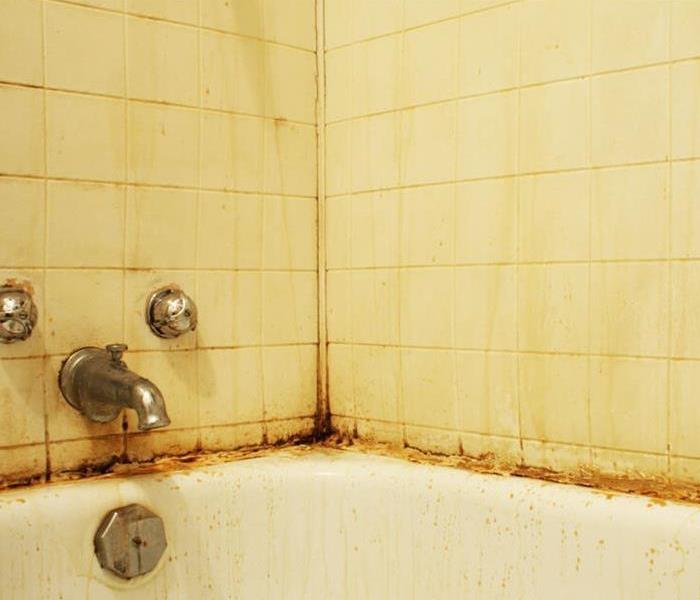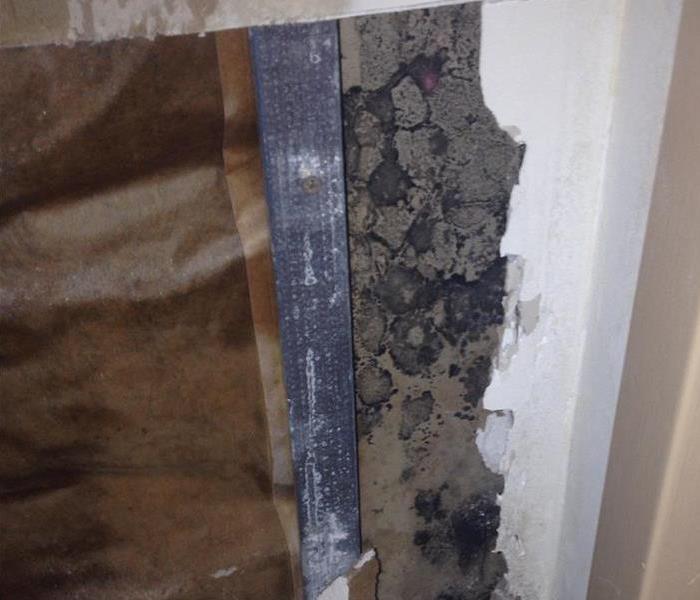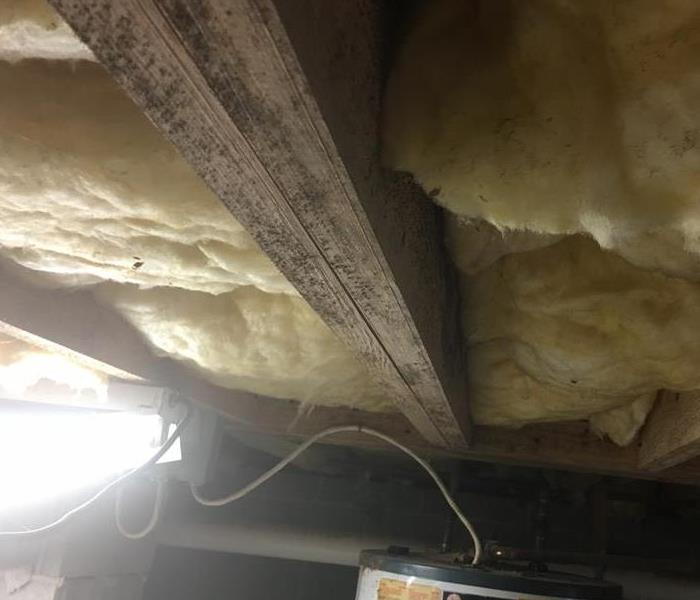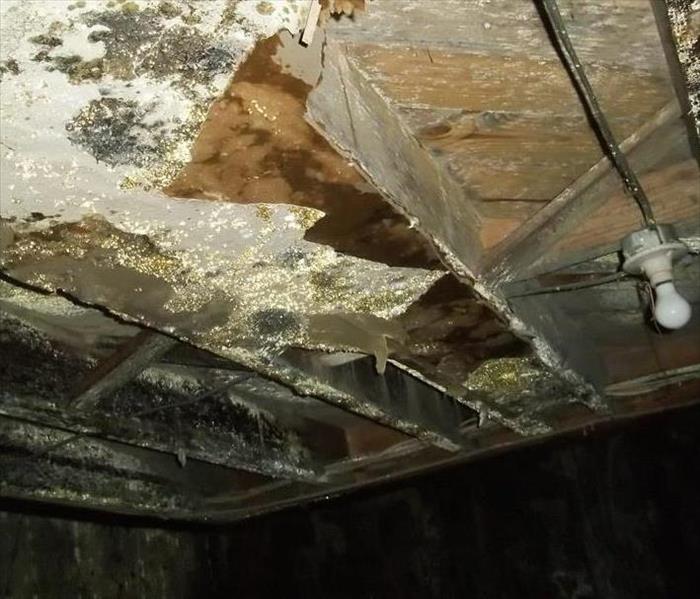Archived Mold Remediation Blog Posts
Preventing and Stopping Indoor Mold Growth
9/6/2019 (Permalink)
 Don't let this happen to you - take precautionary steps to prevent mold.
Don't let this happen to you - take precautionary steps to prevent mold.
The key to preventing and stopping indoor mold growth is controlling excessive moisture and condensation. Keeping problem areas (such as bathrooms, laundry room, kitchen) in the home clean and dry is critical. In general, mold will not grow indoors without water, dampness or excessive moisture.
The three main factors that contribute to condensation of water on building surfaces:
- Relative Humidity: Condensation occurs when the air is saturated with water and it cannot hold any more moisture. For example, steam generated from bathroom showers or from cooking can fill up the air with moisture, which will then condense into drops of water on cooler surfaces, such as mirrors and windows. Where possible, localized sources of humidity, such as clothes dryers, should be directly vented to the outdoors. To lower indoor humidity during warm, humid weather, air conditioners and/or dehumidifiers should be used. In chronically damp areas such as basements or crawlspaces, it is often recommended that dehumidifiers be used to maintain humidity levels below 60 percent.
- Temperature: Warm air holds more moisture than cold air. Condensation occurs when warm humid air comes into contact with a cold surface and the moisture condenses into water. This can often be seen on single-pane windows, where water condenses and then runs down, causing the wood frames and sills to rot and the wall under the windows to blister. Condensation can occur on exterior walls, particularly north-facing walls, if they are not properly insulated. Other chronically cold surfaces, such as cold-water pipes, should be covered with insulation to help prevent condensation.
- Poor Ventilation: Indoor humidity can build up if there is not enough ventilation and exchange of indoor and outdoor air. Where there is little or no air movement, such as behind dressers and cabinets, surfaces can remain cooler than surrounding areas, which can lead to increased condensation and mold growth. It is recommended that the area be ventilated, and the occupants use exhaust fans (vented to the outdoors) to remove moisture from high-humidity areas, particularly in bathrooms, kitchens and laundry areas. Furniture should be moved slightly away from walls so that air can freely pass behind it. Air should be allowed to circulate between rooms and regularly ventilate to remove humid air. Fans should be used as needed.
Other things that can be done are to clean and repair gutters regularly, make sure the ground slopes down and away from the home’s foundation and keep air conditioner drip pans and drain lines clean. In addition, in air-conditioned buildings in hot and humid climates, vinyl wall coverings on the interior sides of exterior walls should not be used, as these materials can trap moisture, resulting in mold growth underneath them.
If you have flooding or leaking pipes, any standing water should be promptly removed, and water-damaged materials should either be dried out and cleaned or removed and replaced. Porous materials that are wet for more than 48 hours are likely to produce mold growth and should be discarded. In instances where the water damage is extensive, it is recommended that professional help. If you have water damage call SERVPRO of Gainesville at 770-536-1010.
Ways to Prevent Mold Growth in Your Bathroom
8/7/2019 (Permalink)
 Mold in bathroom
Mold in bathroom
Whether you are managing a commercial or residential property, fighting mold in the bathroom is necessary if you want a clean and safe bathroom as well as prevent damage to the walls and ceiling.
All bathrooms will have moisture, it goes with the territory, but by eliminating as much moisture as possible in the bathroom, you can stop mold growth or at least slow it down if it does appear.
Maintaining a mold-free bathroom is actually pretty easy if you follow these easy tips and remain diligent in your cleaning effort.
Stop Bathroom Mold Growth with a Good Fan
Effective fans are your first line of defense against mold and moisture. Be sure that all your bathrooms have a well-functioning fan. Make sure the CFM, cubic feet per minute, count is enough to cover the size of the bathroom.
Run the fan during all showers and baths for at least a half hour afterwards. You can put the fan on a timer so that you don’t have to worry about remembering to turn it off.
Fighting Bathroom Mold with a Squeegee
Who knew the bathroom squeegee could be so useful. Using the squeegee on your tub and shower walls after every shower or bath reduces up to 75 percent of the moisture in the air. That alone takes care of so much moisture that can lead to the rapid growth of mold in all areas of the bathroom.
Stop Mold Growth by Fixing All Leaks
If you have any leaks within the bathroom, fix it right away. Call a plumber immediately and have them check for any hidden leaks within the walls. Going a long period of time with any leaks will cause mold growth and will make it hard to get rid of later.
Mold Remediation
If you do ever find mold, have a professional take care of it. Mold is so complicated and getting rid of it is hard. SERVPRO of Gainesviile has trained and certified mold specialists to help you with your mold issues
Mold Prevention
9/14/2018 (Permalink)
Mold can grow anywhere: on carpet, clothing, food, paper, and even in places you can't see, such as the backside of drywall, areas inside walls around leaking or condensing pipes, and above ceiling tiles. Mold spores spread easily and cannot be completely eradicated.
Not only is a mold problem difficult and costly to fix, but mold can also produce allergens and irritants (and, rarely, toxins) that may compromise your health.
What can you do if you're concerned about mold growing in your home?
The best approach is preventing mold before it becomes a problem. The key to mold prevention is simple: moisture control.
Here are nine ways to curb moisture indoors, and the mold that thrives on it.
- Identify problem areas in your home and correct them.You can't mold-proof your home, but you can make it mold-resistant. Do an audit of your home: where are the problem areas? Does the basement flood? Do you notice frequent condensation on an upstairs window? Is there a water stain on the ceiling from a persistent leak? Preventing mold from growing or spreading might be as simple as ripping up carpet in a damp basement, installing mold-resistant products, or repairing damaged gutters. Or it may be a matter of major excavation and waterproofing. Whatever the case, address the problem now. It might cost some money up front, but it will surely be costlier down the road if mold continues to grow unchecked.
- Dry wet areas immediately.Mold can't grow without moisture, so tackle wet areas right away. Seepage into the basement after a heavy rainfall, accumulation from a leaky pipe, even a spill on the carpet should be dried within 24 to 48 hours. If you've experienced a flood, remove water-damaged carpets, bedding, and furniture if they can't be completely dried. Even everyday occurrences need attention: don't leave wet items lying around the house, and make sure to dry the floor and walls after a shower. Don't leave wet clothes in the washing machine, where mold can spread quickly. Hang them to dry — preferably outside or in areas with good air circulation.
- Prevent moisture with proper ventilation.It may be that your routine domestic activities are encouraging the growth of mold in your home. Make sure an activity as simple as cooking dinner, taking a shower, or doing a load of laundry doesn't invite mold by providing proper ventilation in your bathroom, kitchen, laundry room, and any other high-moisture area. Vent appliances that produce moisture — clothes dryers, stoves — to the outside (not the attic). Use AC units and dehumidifiers (especially in humid climates), but make sure they don’t produce moisture themselves by checking them periodically and cleaning them as directed by the manufacturer. Your energy-efficient home may be holding moisture inside, so open a window when cooking or washing dishes or showering or run an exhaust fan.
- Equip your home with mold-resistant products.Building a new home or renovating an old one? Use mold-resistant products like mold-resistant drywall or mold-resistant Sheetrock, and mold inhibitors for paints. Traditional drywall is composed of a gypsum plaster core pressed between plies of paper. Mold-resistant drywall is paperless — the gypsum core is covered in fiberglass, making the surface highly water-resistant. Moisture-resistant drywall is especially valuable in areas prone to wetness, such as bathrooms, laundry rooms, basements, and kitchens. Not only is traditional drywall more susceptible to mold than the paperless kind, but it is also difficult to rid of mold, and removal and replacement can be expensive. Mold-resistant gypsum board is also available; the core of the drywall is developed in such a way to prevent moisture absorption, and thus prevent mold growth.
- Monitor humidity indoors.The EPA recommends keeping indoor humidity between 30 and 60 percent. You can measure humidity with a moisture meter purchased from your local hardware store. You'll also be able to detect high humidity by simply paying attention to potential problem areas in your home. Telltale signs of excessive humidity include condensation on windows, pipes, and walls. If you notice condensation, dry the surface immediately and address the source of moisture (for example, turn off a humidifier if water appears on the inside of nearby windows).
- Direct water away from your home.If the ground around your home isn't sufficiently sloped away from the foundation, water may collect there and seep into your crawlspace or basement.
- Clean or repair roof gutters.A mold problem might be a simple matter of a roof that is leaking because of full or damaged gutters. Have your roof gutters cleaned regularly and inspected for damage. Repair them as necessary and keep an eye out for water stains after storms that may indicate a leak.
- Improve air flow in your home.According to the EPA, as temperatures drop, the air can hold less moisture. Without good air flow in your home, that excess moisture may appear on your walls, windows and floors. To increase circulation, open doors between rooms, move furniture away from walls, and open doors to closets that may be colder than the rooms they’re in. Let fresh air in to reduce moisture and keep mold at bay.
- Keep mold off household plants.They're beautiful and help keep your indoor air clean — and mold loves them. The moist soil in indoor plants is a perfect breeding ground for mold, which may then spread to other areas of your house. Instead of getting rid of your plants, try adding a bit of Taheebo tea to the water you give to your houseplants. The oil of this tree, which withstands fungi even in rain forests, helps hinder mold growth in plant soil and can be found at natural food stores.
Finally, educate yourself on your region's climate — be it the cold and wet Northeast, the hot and wet South, the hot and dry Southwest, or the cold and dry West — and how it responds to moisture. There is no one-size-fits-all solution when it comes to mold prevention. Knowing what works for your climate and your home is an important first step.
The Mold Remediation Process
9/14/2018 (Permalink)
When mold is not visible, SERVPRO recommends hiring a hygienist to perform an air quality test to properly determine the affected areas in the home or business. But when the mold has spread more than 10 square feet then there is a process that begins towards addressing it properly and efficiently:
- Assessment-Your property will be carefully inspected for signs of mold and the water sources possibly causing it. Mold feeds on cellulose and water and can be hidden from plain view.
- Containment- Different containment procedures will be placed to prevent the spread of mold, like physical barriers and negative air pressure to keep the mold spores from spreading during the cleanup process.
- Air Filtration- Specialized filtration equipment captures microscopic mold spores out of the air. SERVPRO technicians use air scrubbers and HEPA vacuums to prevent the spread of these mold spores while the mold remediation is in progress.
- Removing- The process of mold remediation depends on the amount of mold growth and the type of surface it's on. Antimicrobial treatments will be used to eliminate mold colonies and help prevent new ones from forming. Removing and disposing of mold-infested porous materials, like drywall and flooring, may be necessary.
- Cleaning- SERVPRO cleans your furniture, decorative items, and other restorable items affected by mold. We use a variety of cleaning techniques to clean and sanitize your belongings.
- Restoration- Depending on the level of mold damage, some building materials may have to be removed. Restoration may involve minor repairs or major repairs.
Types of Mold
9/10/2018 (Permalink)

There are many different types and subspecies of mold that may grow in a house. If you have found mold in your home or smell an odor that leads you to suspect the presence of hidden mold, you should contact a certified hygienists service that provides testing, clean-up, and restoration services. Skilled professionals can determine whether mold growth poses a risk to any member of the household and limit your family's exposure.
• Aspergillus is a common genus of mold found on food such as bread or potatoes and in HVAC systems. This type of mold is highly aerobic and depends on the presence of oxygen to thrive.
• Cladosporium is black or green mold growth that often forms on air ducts, toilets, or painted surfaces in high humidity or when excessive moisture is present.
• Black mold is a type of mold that is known to cause problems for residents in homes with substantial growths. The scientific name for black mold is stachybotrys chartarum. This type of mold should be identified and handled only by mold experts.
• White mold tends to be in the early stages of growth. A reputable service should be able to prevent this type of mold from continuing to grow into mature colonies. White or light grey molds on plants are mildew – a related type of fungus.
These are just a few of the major types of mold growth that you may see in a home in the wake of water damage. You may attempt to identify visible mold in your home, but when it comes to determining the real risk posed by mold and eliminating its presence, you should rely on trained hygienists and remediation experts in Gainesville, Georgia. These specialists can provide accurate results with either microscopy or culturing and determine the type or subspecies of mold and the best way to eliminate it from your home.
Call us at SERVPRO of Gainesville, 770-536-1010 for more information.
Keep your HVAC System to Reduce the Chances of Microbial Growth
9/10/2018 (Permalink)
Mold in HVAC (heating, ventilation and air conditioning) systems can cause serious health problems. When the furnace or air conditioner is turned on, microscopic mold spores can blow out of the air ducts and circulate through the air, where they are easily inhaled.
Keeping your Ducting and the Intake clean is vital to reducing the amount of contamination your HVAC system has.
If you see visible mold, do not disturb it. You can inadvertently spread the mold infestation throughout your home. When mold is disturbed, the mold can release microscopic mold spores which become airborne and can circulate inside your home.
What to Do:
- Stay out of affected areas.
- Turn off the HVAC system and fans.
- Contact SERVPRO for mold remediation services.
What Not to Do:
- Don’t touch or disturb the mold.
- Don’t blow air across any surfaces with visible or suspected mold growth.
- Don’t attempt to dry the area yourself.
- Don’t spray bleach or other disinfectants on the mold.
About Our Mold Remediation Services
SERVPRO specializes in mold cleanup and restoration, in fact, it’s a cornerstone of our business. Our crews are highly trained restoration professionals that use specialized equipment and techniques to properly remediate your mold problem quickly and safely.
If You See Signs of Mold, Call Us Today SERVPRO of Gainesville, 770-536-1010
How to prevent mold growth
9/7/2018 (Permalink)
 Mold is often hidden in wall cavities where long term leaks may go undetected for some time.
Mold is often hidden in wall cavities where long term leaks may go undetected for some time.
The key to preventing and stopping indoor mold growth is to control excessive moisture and condensation. Keeping susceptible areas in the home clean and dry is critical. In general, mold will not grow indoors without water, dampness or excessive moisture.
The three main factors that contribute to condensation of water on building surfaces:
- Relative Humidity: Condensation occurs when the air is saturated with water and it cannot hold any more moisture. For example, steam generated from bathroom showers or from cooking can fill up the air with moisture, which will then condense into drops of water on cooler surfaces, such as mirrors and windows. Where possible, localized sources of humidity, such as clothes dryers, should be directly vented to the outdoors. To lower indoor humidity during warm, humid weather, air conditioners and/or dehumidifiers should be used. In chronically damp areas such as basements or crawlspaces, it is often recommended that dehumidifiers be used to maintain humidity levels below 60 percent.
- Temperature: Warm air holds more moisture than cold air. Condensation occurs when warm humid air comes into contact with a cold surface and the moisture condenses into water. This can often be seen on single-pane windows, where water condenses and then runs down, causing the wood frames and sills to rot and the wall under the windows to blister. Condensation can occur on exterior walls, particularly north-facing walls, if they are not properly insulated. Other chronically cold surfaces, such as cold-water pipes, should be covered with insulation to help prevent condensation.
- Poor Ventilation: Indoor humidity can build up if there is not enough ventilation and exchange of indoor and outdoor air. Where there is little or no air movement, such as behind dressers and cabinets, surfaces can remain cooler than surrounding areas, which can lead to increased condensation and mold growth. It is recommended that the area be ventilated, and the occupants use exhaust fans (vented to the outdoors) to remove moisture from high-humidity areas, particularly in bathrooms, kitchens and laundry areas. Furniture should be moved slightly away from walls so that air can freely pass behind it. Air should be allowed to circulate between rooms and regularly ventilate to remove humid air. Fans should be used as needed.
Other things that can be done are to clean and repair gutters regularly, make sure the ground slopes down and away from the home’s foundation and keep air conditioner drip pans and drain lines clean. In addition, in air-conditioned buildings in hot and humid climates, vinyl wall coverings on the interior sides of exterior walls should not be used, as these materials can trap moisture, resulting in mold growth underneath them.
In the case of floods or leaking pipes, any standing water should be promptly removed, and water-damaged materials should either be dried out and cleaned or removed and replaced. Porous materials that are wet for more than 48 hours are likely to produce mold growth and should be discarded. In instances where the water damage is extensive, it is recommended that professional help. If you’ve had water damage call SERVPRO of Gainesville at 770-536-1010.
Mold in Crawlspaces
9/7/2018 (Permalink)
 Mold can be found on the floor joist and in insulation in crawlspaces.
Mold can be found on the floor joist and in insulation in crawlspaces.
In the humid south, moisture is constantly present in the air. Combining moisture with a dark and undisturbed area, such as a crawlspace, will often lead to mold growth.
Crawlspaces are rarely bothered by homeowners as they are usually small, dark, closed off, and house various bugs or other unwanted critters. When we avoid crawl spaces however, we prevent air circulation and sunlight in the area. The unbothered area is an ideal place for mold growth because moisture is not evaporated, and the temperature is kept relatively constant.
Mold thrives in areas that are moist and kept at a temperature ranging from 60 to 80 degrees. A crawl space ends up being an ideal place for mold growth due to its environmental conditions.
Considering you don’t regularly go into your crawl space, and it isn’t open to the rest of your home, you may think a little mold is nothing to worry about. Unfortunately, mold in these areas can still affect your and your family’s health.
Mold spores are tiny and easily released into the air. Spores can slip through cracks, be pulled in from air conditioning systems, or even float through open doors or windows. The mold spores can cause adverse health effects from allergic reactions to infections when breathed in on a regular basis.
Concerned about mold in your crawlspace? Call SERVPRO of Gainesville at 770-536-1010.
Does Your Hall County Home Have a Mold Problem?
7/19/2017 (Permalink)
 In Hall County, mold can spread through a home in as little as 48 hours.
In Hall County, mold can spread through a home in as little as 48 hours.
Microscopic mold spores naturally occur almost everywhere, both outdoors and indoors. This makes it impossible to remove all mold from a home or business. Therefore, mold remediation reduces the mold spore count back to its natural or baseline level. Some restoration businesses advertise “mold removal” and even guarantee to remove all mold, which is a fallacy. Consider the following mold facts:
- Mold is present almost everywhere, indoors and outdoors.
- Mold spores are microscopic and float along in the air and may enter your home through windows, doors, or AC/heating systems or even hitch a ride indoors on your clothing or a pet.
- Mold spores thrive on moisture. Mold spores can quickly grow into colonies when exposed to water. These colonies may produce allergens and irritants.
- Before mold remediation can begin, any sources of water or moisture must be addressed. Otherwise, the mold may return.
- Mold often produces a strong, musty odor and can lead you to possible mold problem areas.
- Even higher-than-normal indoor humidity can support mold growth. Keep indoor humidity below 45 percent.
If your home or business has a mold problem, we can inspect and assess your property and use our specialized training, equipment, and expertise to remediate your mold infestation.
If You See Signs of Mold, Call Us Today – (770) 536-1010

 24/7 Emergency Service
24/7 Emergency Service





